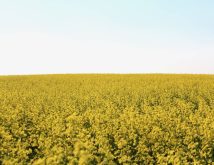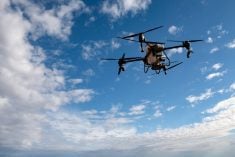Neonicotinoids used as a seed treatment remain the safest and most effective tool for managing flea beetles, an entomologist says.
Neonicotinoids are a widely used class of insecticides available since the 1990s. Concerns about their environmental impact emerged in the early 2000s, when studies showed they caused harm to honeybees and other pollinators. These findings led to calls for stricter regulations on use of neonics, with some regions, most notably the European Union, banning their use.
“The European Union basically put a gun to their rapeseed farmers’ heads and said ‘we’re taking away the neonicotinoid treatments’,” said Tyler Wist, an entomologist with Agriculture and Agri-Food Canada, speaking at Manitoba Ag Days Jan. 19.
Read Also

Journal pulls long-cited glyphosate study for ethics violations
The journal Regulatory Toxicology and Pharmacology has retracted a 2000 Monsanto-linked glyphosate review, drawing new scrutiny as Bayer faces mounting legal pressure.
There are few alternatives to control flea beetles, and those that do exist have their own issues.
In 2013, the EU placed a moratorium on use of neonics in agriculture: no seed treatments, no soil applications and no foliar applications.
Wist said the ban, specifically in terms of seed treatments, made little sense.
“It’s only the insects that are feeding on the plants that are getting dosed by that insecticide. None of our beneficial insects are eating the insecticide,” he said.
“It’s very targeted. You’ve got a tiny amount of active ingredient going into the plant, and by the time that plant is flowering, there’s really no active ingredient left in the plant. It made no sense to me that they thought they were getting dosed from neonics from this tiny amount.”

In 2017, an assessment of the economic and environmental costs of the seed treatment moratorium was published in the journal HFFA Research GmbH, indicating the ban was more costly than many expected.
The paper’s author, Steffen Noleppa, combined data from 13 studies done on the (mainly agronomic) impact of the ban’s effect on oilseed rape production in the EU.
Not only was there significant yield loss (about 900,000 tonnes annually) and economic impact (more than US$1 billion per year in revenue losses and other impacts), but the ban also had limited environmental benefit.
“Not applying a… neonicotinoid treatment may have some positive implications, but definitely causes much more negative disturbances,” Noleppa wrote in the executive summary.
The environmental issues included increased CO2 emissions and water consumption because seed treatments were replaced with foliar treatments of insecticides that don’t contain neonics. Also, the alternative insecticides kill other insects, including pollinators, and the lost acres of flowering plants due to crop degradation also meant less food for pollinators.
On top of that, flea beetles began developing resistance to foliar sprays used for insect control (mostly pyrethroids).
While Wist acknowledged that flea beetles could also become resistant to neonics, it hasn’t happened yet.
Despite these findings, the EU ban was made permanent in 2018 and expanded to include all outdoor uses of the three most widely used neonicotinoids: imidacloprid, clothianidin, and thiamethoxam.
“When a moratorium like this happens in another country, it triggers other countries to start looking at those kinds of things as well,” said Wist.
In August 2018, citing “unacceptable risk to aquatic invertebrates,” Canada’s Pest Management Regulatory Agency proposed banning all outdoor use of seed treatments that use clothianidin and thiamethoxam. Had that ban been imposed, those products would not have been available in 2024.
But studies done in 2019 showed little of the chemicals got into waterways, and even in samples where neonics were found, levels weren’t at the threshold considered dangerous.
So, at least until the next review, those seed treatments remain available to farmers.
From Wist’s perspective, that’s good because there aren’t many alternatives available, and foliar sprays are time-consuming and difficult to manage.
“You need to be doing daily counting because damage can occur quickly,” he said.
Wist also pointed to human health issues caused by drift associated with foliar spraying, “and you’re going to get drift into water bodies in much higher concentrations.
“Then, of course, near and dear to my heart is the harm to the beneficial insects. Synthetic pyrethroid sprays are toxic to ground beetles for one week after spraying. You want to protect this unseen army in your field.”
Wist said work by Canola Council of Canada agronomists showed that, in the absence of rove beetles (a type of ground beetle), flea beetle populations increase.
















